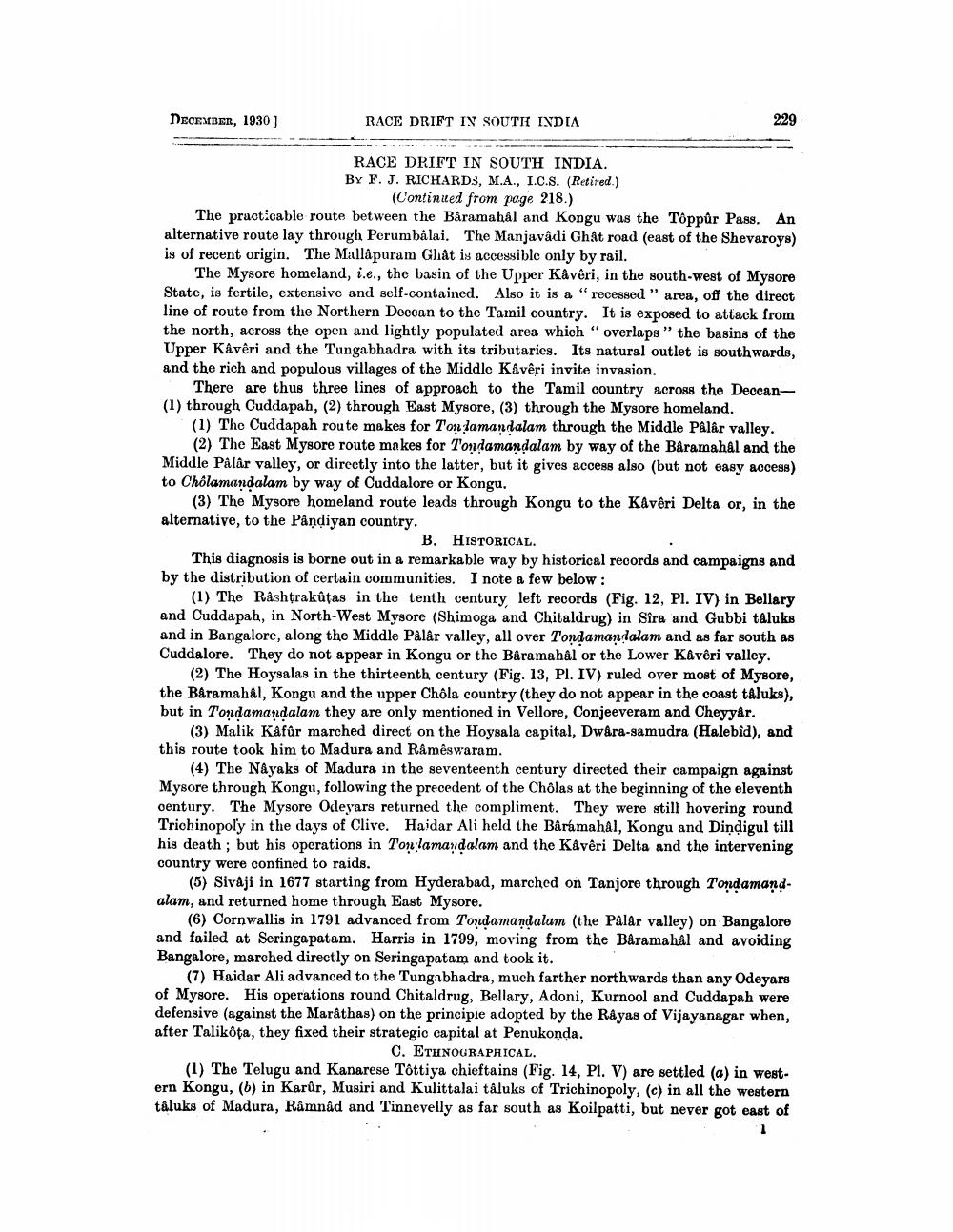________________
DECEMBER, 1930 ]
RACE DRIFT IN SOUTH INDIA
229
RACE DRIFT IN SOUTH INDIA. BY F. J. RICHARDS, M.A., I.C.S. (Retired.)
(Continued from page 218.) The practicable route between the Bâramahal and Kongu was the Toppûr Pass. An alternative route lay through Perumbalai. The Manjavâdi Ghát road (east of the Shevaroys) is of recent origin. The Mallapuram Ghật is accessible only by rail.
The Mysore homeland, i.e., the basin of the Upper Kåvêri, in the south-west of Mysore State, is fertile, extensive and self-contained. Also it is a "recessedarea, off the direct line of route from the Northern Deccan to the Tamil country. It is exposed to attack from the north, across the open and lightly populated area which "overlaps " the basins of the Upper Kávéri and the Tungabhadra with its tributarics. Its natural outlet is southwards, and the rich and populous villages of the Middlo Kåveri invite invasion.
There are thus three lines of approach to the Tamil country across the Deocan(1) through Cuddapah, (2) through East Mysore, (3) through the Mysore homeland.
(1) The Cuddapah route makes for Ton damandalam through the Middle Palêr valley.
(2) The East Mysore route makes for Tondamandalam by way of the Baramahal and the Middle Palar valley, or directly into the latter, but it gives access also (but not easy access) to Chólamandalam by way of Cuddalore or Kongu.
(3) The Mysore homeland route leads through Kongu to the Kavêri Delta or, in the alternative, to the Påndiyan country.
B. HISTORICAL. This diagnosis is borne out in a remarkable way by historical records and campaigns and by the distribution of certain communities. I note a few below:
(1) The Rashtrakatas in the tenth century left records (Fig. 12, PI. IV) in Bellary and Cuddapah, in North-West Mysore (Shimoga and Chitaldrug) in Sfra and Gubbi taluks and in Bangalore, along the Middle Palár valley, all over Tondamandalam and as far south as Cuddalore. They do not appear in Kongu or the Bâramahal or the Lower Kavêri valley.
(2) The Hoysalas in the thirteenth century (Fig. 13, PI. IV) ruled over most of Mysore, the Baramahal, Kongu and the upper Chôla country (they do not appear in the coast taluks), but in Tondamandalam they are only mentioned in Vellore, Conjeeveram and Cheyyår.
(3) Malik Kafür marched direct on the Hoysala capital, Dwara-samudra (Halebid), and this route took him to Madura and Rameswaram.
(4) The Nayaks of Madura in the seventeenth century directed their campaign against Mysore through Kongu, following the precedent of the Cholas at the beginning of the eleventh oentury. The Mysore Odeyars returned the compliment. They were still hovering round Trichinopoly in the days of Clive. Haidar Ali held the Bârámahal, Kongu and Dindigul till his death ; but his operations in Ton-lamandalam and the Kávêri Delta and the intervening country were confined to raids.
(5) Sivaji in 1677 starting from Hyderabad, marched on Tanjore through Tondamandalam, and returned home through East Mysore.
(6) Cornwallis in 1791 advanced from Tondamandalam (the Palar valley) on Bangalore and failed at Seringa patam. Harris in 1799, moving from the Baramahal and avoiding Bangalore, marched directly on Seringapatam and took it.
(7) Haidar Ali advanced to the Tungabhadra, much farther northwards than any Odeyars of Mysore. His operations round Chitaldrug, Bellary, Adoni, Kurnool and Cuddapah were defensive (against the Marathas) on the principle adopted by the Rayas of Vijayanagar when, after Talikota, they fixed their strategic capital at Penukonda.
C. ETHNOGRAPHICAL. (1) The Telugu and Kanarese Tóttiya chieftains (Fig. 14, P1. V) are settled (a) in western Kongu, (b) in Karûr, Musiri and Kulittalai taluks of Trichinopoly, (c) in all the western taluks of Madura, Râmnad and Tinnevelly as far south as Koilpatti, but never got east of




